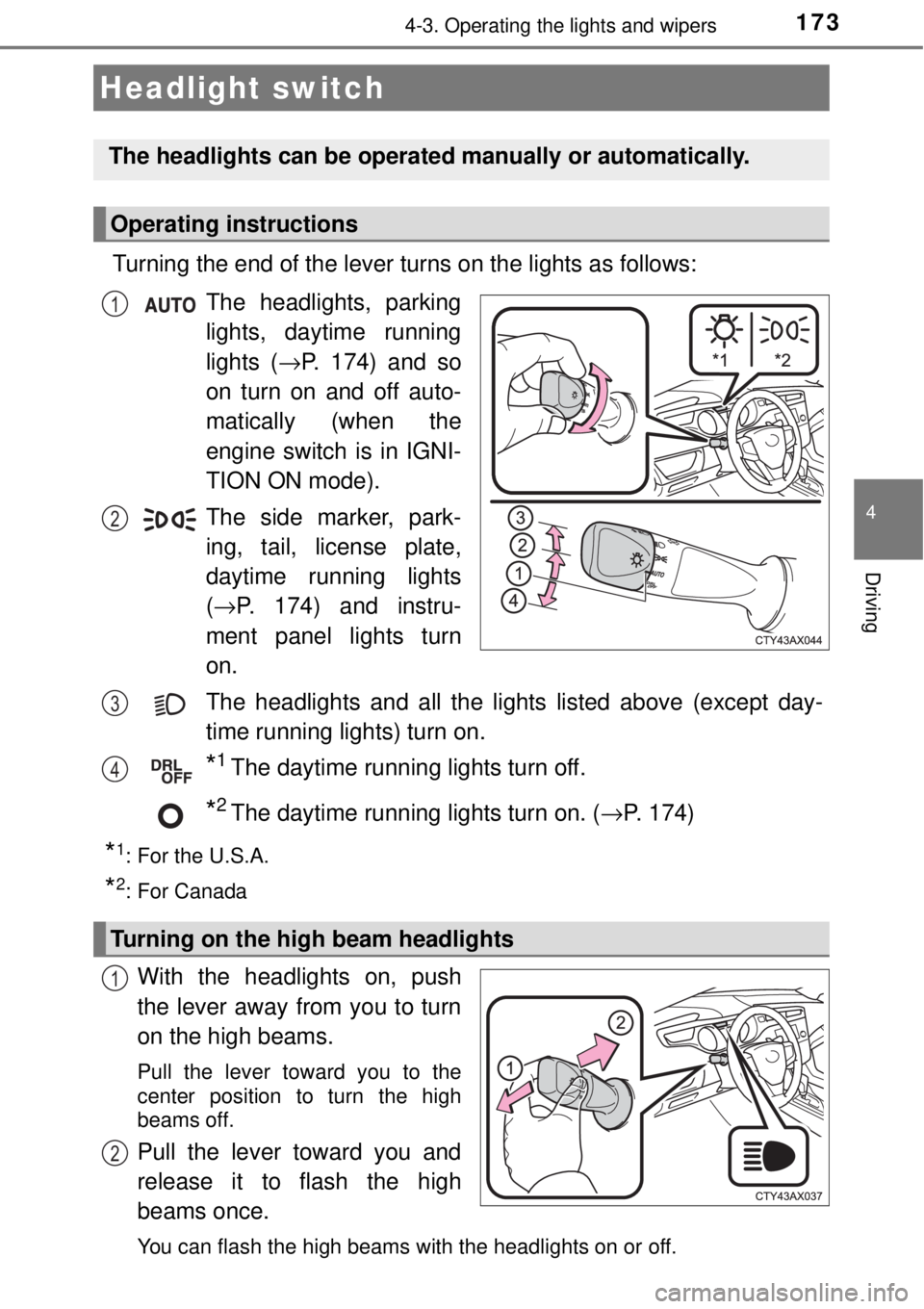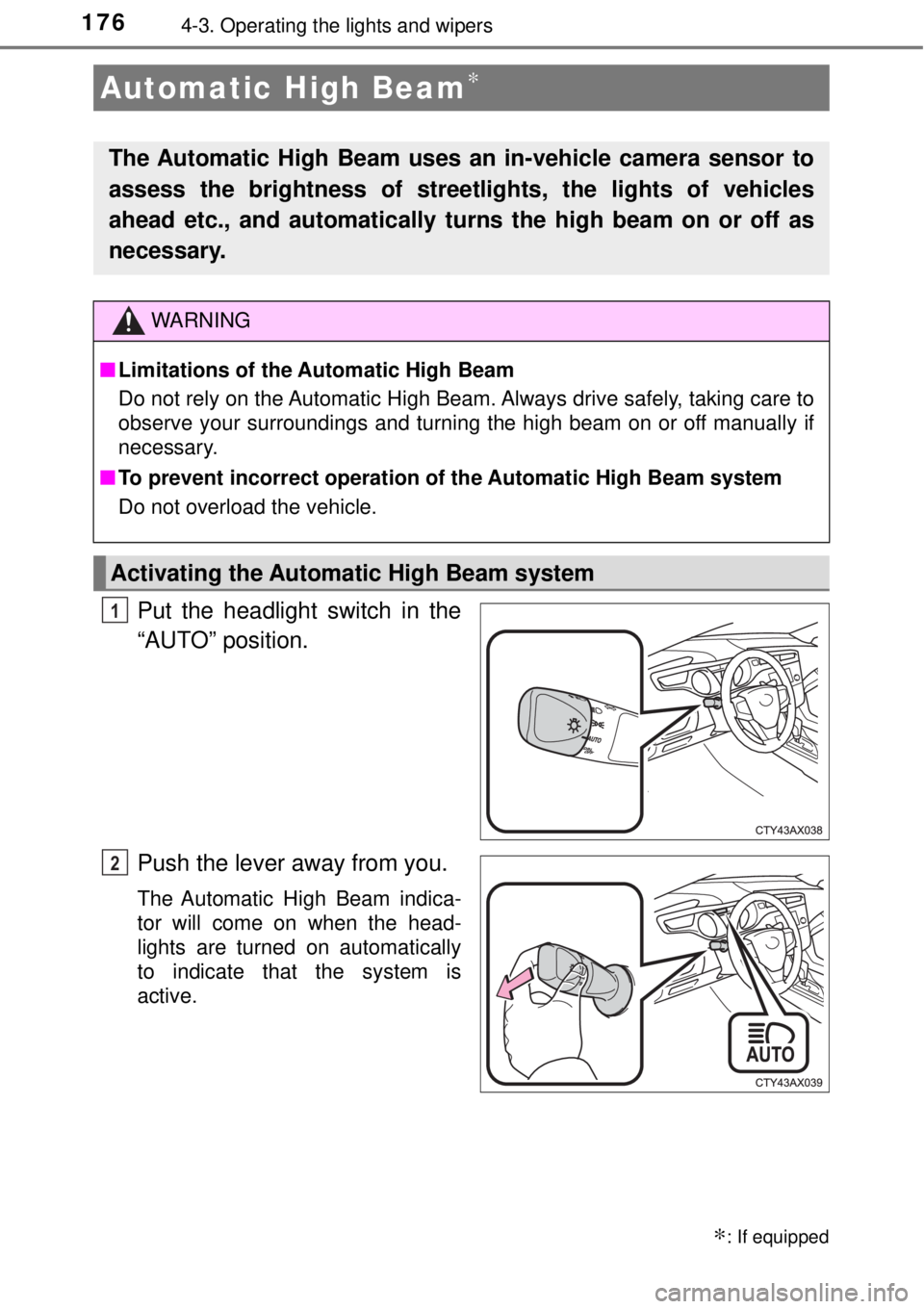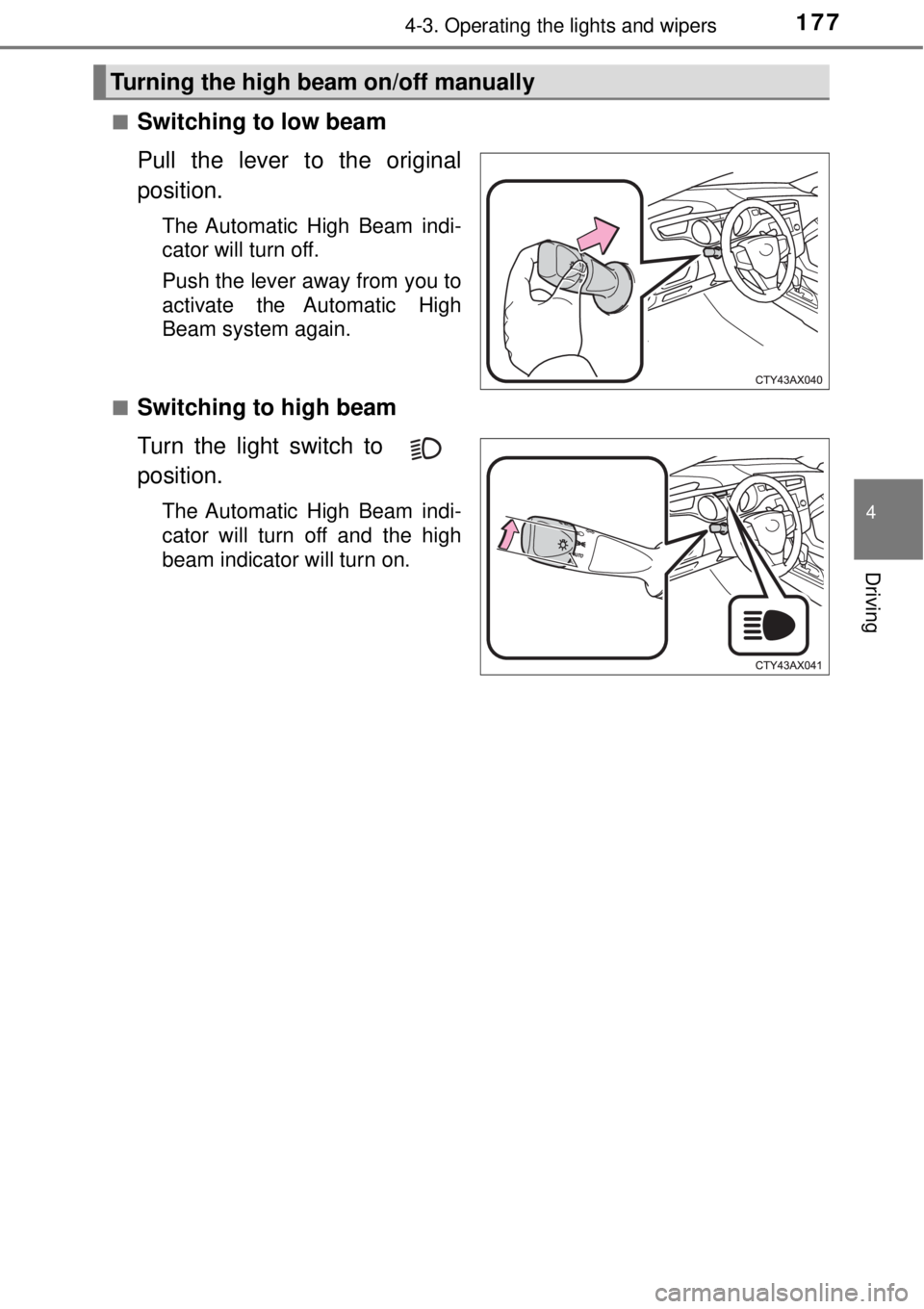wipers TOYOTA AVALON 2018 Owners Manual (in English)
[x] Cancel search | Manufacturer: TOYOTA, Model Year: 2018, Model line: AVALON, Model: TOYOTA AVALON 2018Pages: 492, PDF Size: 7.19 MB
Page 3 of 492

3
1
8 7
6
5
4
3
2
9
4-1. Before drivingDriving the vehicle ............. 144
Cargo and luggage............ 154
Vehicle load limits ............. 157
Trailer towing..................... 158
Dinghy towing.................... 159
4-2. Driving procedures Engine (ignition) switch .............................. 160
Automatic transmission .................... 165
Turn signal lever................ 171
Parking brake .................... 172
4-3. Operating the lights and wipers
Headlight switch ................ 173
Automatic High Beam ....... 176
Windshield wipers and washer ..................... 180
4-4. Refueling Opening the fuel tank cap .......................... 186 4-5. Using the driving
support systems
Toyota Safety Sense P ...... 190
PCS (Pre-Collision System)..... 198
LDA (Lane Departure Alert
with steering control) ....... 211
Dynamic radar cruise control.............................. 222
Cruise control .................... 235
BSM (Blind Spot Monitor)......... 239
• The Blind Spot Monitor function............. 241
• The Rear Cross Traffic Alert function ................. 245
Driving mode select switches........................... 248
Driving assist systems ....... 250
4-6. Driving tips Winter driving tips .............. 255
4Driving
Page 15 of 492

15Pictorial index
Windshield wipers . . . . . . . . . . . . . . . . . . . . . . . . . . . . . . . . . P. 180
Precautions against winter season . . . . . . . . . . . . . . . . . . . . . P. 255
Precautions against car wash . . . . . . . . . . . . . . . . . . . . . . . . . P. 314
Fuel filler door . . . . . . . . . . . . . . . . . . . . . . . . . . . . . . . . . . . . P. 186
Refueling method . . . . . . . . . . . . . . . . . . . . . . . . . . . . . . . . . . . P. 186
Fuel type/fuel tank capacity . . . . . . . . . . . . . . . . . . . . . . . . . . . P. 426
Tires . . . . . . . . . . . . . . . . . . . . . . . . . . . . . . . . . . . . . . . . . . P. 342
Tire size/inflation pressure . . . . . . . . . . . . . . . . . . . . . . . . . P. 431
Winter tires/tire chain . . . . . . . . . . . . . . . . . . . . . . . . . . . . . P. 255
Checking/rotation/tire pressure warning system . . . . . . . . . P. 342
Coping with flat tires . . . . . . . . . . . . . . . . . . . . . . . . . . . . . . P. 397
Hood . . . . . . . . . . . . . . . . . . . . . . . . . . . . . . . . . . . . . . . . . . . . P. 328
Opening . . . . . . . . . . . . . . . . . . . . . . . . . . . . . . . . . . . . . . . . . . P. 328
Engine oil . . . . . . . . . . . . . . . . . . . . . . . . . . . . . . . . . . . . . . . . . P. 426
Coping with overheat . . . . . . . . . . . . . . . . . . . . . . . . . . . . . . . . P. 418
Headlights/daytime running lights
*. . . . . . . . . . . . . . . . . . . P. 173
Parking lights
*/daytime running lights* . . . . . . . . . . . . . . . P. 173
Front turn signal/parking lights
* . . . . . . . . . . . . . . . . . . . . . P. 171
Side marker lights . . . . . . . . . . . . . . . . . . . . . . . . . . . . . . . . . P. 173
Stop/tail lights . . . . . . . . . . . . . . . . . . . . . . . . . . . . . . . . . . . . P. 173
Rear turn signal lights . . . . . . . . . . . . . . . . . . . . . . . . . . . . . . P. 171
Back-up lights
Shifting the shift lever to R . . . . . . . . . . . . . . . . . . . . . . . . . . . . P. 165
License plate lights . . . . . . . . . . . . . . . . . . . . . . . . . . . . . . . . P. 173
4
5
6
7
Light bulbs of the exter ior lights for driving
(Replacing method: P. 365, Wattages: P. 432)
*: If equipped
8
9
10
11
12
13
14
Page 143 of 492

143
Driving4
4-1. Before drivingDriving the vehicle ............. 144
Cargo and luggage ........... 154
Vehicle load limits ............. 157
Trailer towing..................... 158
Dinghy towing ................... 159
4-2. Driving procedures Engine (ignition) switch .............................. 160
Automatic transmission .................... 165
Turn signal lever................ 171
Parking brake .................... 172
4-3. Operating the lights and wipers
Headlight switch ................ 173
Automatic High Beam ....... 176
Windshield wipers and washer ............................ 180
4-4. Refueling Opening the fuel tank cap .......................... 186 4-5. Using the driving
support systems
Toyota Safety Sense P ..... 190
PCS (Pre-Collision
System)........................... 198
LDA (Lane Departure Alert
with steering control) ....... 211
Dynamic radar cruise control ............................. 222
Cruise control .................... 235
BSM (Blind Spot Monitor) ........ 239
• The Blind Spot Monitor function ............ 241
• The Rear Cross Traffic Alert
function ......................... 245
Driving mode select switches .......................... 248
Driving assist systems ...... 250
4-6. Driving tips Winter driving tips ............. 255
Page 173 of 492

173
4
Driving
4-3. Operating the lights and wipers
Turning the end of the lever turns on the lights as follows:The headlights, parking
lights, daytime running
lights (→P. 174) and so
on turn on and off auto-
matically (when the
engine switch is in IGNI-
TION ON mode).
The side marker, park-
ing, tail, license plate,
daytime running lights
( → P. 174) and instru-
ment panel lights turn
on.
The headlights and all the lights listed above (except day-
time running lights) turn on.
*1The daytime running lights turn off.
*2The daytime running lights turn on. ( →P. 174)
*1: For the U.S.A.
*2: For Canada
With the headlights on, push
the lever away from you to turn
on the high beams.
Pull the lever toward you to the
center position to turn the high
beams off.
Pull the lever toward you and
release it to flash the high
beams once.
You can flash the high beams with the headlights on or off.
Headlight switch
The headlights can be operated manually or automatically.
Operating instructions
1
2
3
4
Turning on the high beam headlights
1
2
Page 174 of 492

1744-3. Operating the lights and wipers
■Daytime running light system
●Vehicles with halogen headlights (low beam):
The daytime running lights illuminate the headlight high beams, and they
are darker than the headlight high beams.
Vehicles with discharge headlights (low beam) or LED headlights:
The daytime running lights illuminate the parking lights, and they are
brighter than parking lights.
● To make your vehicle more visible to other drivers during daytime driving,
the daytime running lights turn on automatically when all of the following
conditions are met. (The daytime running lights are not designed for use at
night.)
• The engine is running
• The parking brake released
• The headlight switch is in (Canada only), or (when the
surroundings are bright) position
The daytime running lights remain on after they illuminate due to the condi-
tions above, even if the parking brake is set again.
● For the U.S.A.: Daytime running lights can be turned off by operating the
switch.
● Compared to turning on the headlights, the daytime running light system
offers greater durability and consumes less electricity, so it can help improve
fuel economy.
■ Headlight control sensor
■ Automatic light off system
●When the headlights are on: The headlights and tail lights turn off 30 sec-
onds after the engine switch is turned off and a door is opened and all of the
doors and trunk are closed. (The lights turn off immediately if on the
key is pressed twice after all the doors are closed.)
● When only the tail lights are on: The tail lights turn off automatically if the
engine switch is turned off and the driver’s door is opened.
To turn the lights on again, turn the engine switch to IGNITION ON mode, or
turn the light switch off once and then back to or .
If any of the doors or trunk lid is kept open, the lights automatically turn off
after 20 minutes. The sensor may not function properly if an
object is placed on the sensor, or anything
that blocks the sensor is affixed to the
windshield.
Doing so interferes with the sensor
detecting the level of ambient light and
may cause the automatic headlight sys-
tem to malfunction.
Page 175 of 492

1754-3. Operating the lights and wipers
4
Driving
■Light reminder buzzer
A buzzer sounds when the engine switch is turned off or turned to ACCES-
SORY mode and the driver’s door is opened while the lights are turned on.
■ Automatic headlight leveling system (if equipped)
The level of the headlights is automatically adjusted according to the n\
umber
of passengers and the loading condition of the vehicle to ensure that the
headlights do not interfere with other road users.
■ Customization
Settings (e.g. light sensor sensitivity) can be changed.
(Customizable features: →P. 449)
NOTICE
■To prevent battery discharge
Do not leave the lights on longer than necessary when the engine is not
running.
Page 176 of 492

1764-3. Operating the lights and wipers
Put the headlight switch in the
“AUTO” position.
Push the lever away from you.
The Automatic High Beam indica-
tor will come on when the head-
lights are turned on automatically
to indicate that the system is
active.
Automatic High Beam∗
∗: If equipped
The Automatic High Beam uses an in-vehicle camera sensor to
assess the brightness of streetlights, the lights of vehicles
ahead etc., and automatically turns the high beam on or off as
necessary.
WARNING
■Limitations of the Automatic High Beam
Do not rely on the Automatic High Beam. Always drive safely, taking care to
observe your surroundings and turning the high beam on or off manually if
necessary.
■ To prevent incorrect operation of the Automatic High Beam system
Do not overload the vehicle.
Activating the Automatic High Beam system
1
2
Page 177 of 492

1774-3. Operating the lights and wipers
4
Driving
■Switching to low beam
Pull the lever to the original
position.
The Automatic High Beam indi-
cator will turn off.
Push the lever away from you to
activate the Automatic High
Beam system again.
■
Switching to high beam
Turn the light switch to
position.
The Automatic High Beam indi-
cator will turn off and the high
beam indicator will turn on.
Turning the high beam on/off manually
Page 178 of 492

1784-3. Operating the lights and wipers
■High beam automatic turning on or off conditions
●When all of the following conditions are fulfilled, the high beam will be auto-
matically turned on (after approximately 1 second):
• Vehicle speed is above approximately 25 mph (40 km/h).
• The area ahead of the vehicle is dark.
• There are no vehicles ahead with headlights or tail lights turned on.
• There are few streetlights on the road ahead.
● If any of the following conditions are fulfilled, the high beam will be automat-
ically turned off:
• Vehicle speed drops below approximately 19 mph (30 km/h).
• The area ahead of the vehicle is not dark.
• Vehicles ahead have headlights or tail lights turned on.
• There are many streetlights on the road ahead.
■ Camera sensor detection information
●The high beam may not be automatically turned off in the following situa-
tions:
• When oncoming vehicles suddenly appear from a curve
• When the vehicle is cut in front of by another vehicle
• When vehicles ahead are hidden from sight due to repeated curves, road
dividers or roadside trees
• When vehicles ahead appear from the faraway lane on wide road
• When vehicles ahead have no lights
● The high beam may be turned off if a vehicle ahead that is using fog lights
without using the headlights is detected.
● House lights, street lights, traffic signals, and illuminated billboards or signs
may cause the high beam to switch to the low beams, or the low beams to
remain on.
● The following factors may affect the amount of time taken to turn the high
beam on or off:
• The brightness of headlights, fog lights, and tail lights of vehicles ahe\
ad
• The movement and direction of vehicles ahead
• When a vehicle ahead only has operational lights on one side
• When a vehicle ahead is a two-wheeled vehicle
• The condition of the road (gradient, curve, condition of the road surface
etc.)
• The number of passengers and amount of luggage
● The high beam may be turned on or off when the driver does not expect it.
● Bicycles or similar objects may not be detected.
Page 179 of 492

1794-3. Operating the lights and wipers
4
Driving
●In the situations shown below, the system may not be able to accurately
detect surrounding brightness levels. This may cause the low beams to
remain on or the high beams to cause problems for pedestrians, vehicles
ahead or other parties. In these cases, manually switch between the high
and low beams.
• In bad weather (rain, snow, fog, sandstorms etc.)
• The windshield is obscured by fog, mist, ice, dirt etc.
• The windshield is cracked or damaged.
• The inside rear view mirror or ca mera sensor is deformed or dirty.
• The camera sensor temperature is extremely high.
• Surrounding brightness levels are equal to those of headlights, tail lights or fog lights.
• Vehicles ahead have headlights that are either switched off, dirty, are
changing color, or have are not aimed properly.
• When driving through an area of in termittently changing brightness and
darkness.
• When frequently and repeatedly driving ascending/descending roads, or roads with rough, bumpy or uneven surfaces (such as stone-paved
roads, gravel tracks etc.).
• When frequently and repeatedly taking curves or driving on a winding road.
• There is a highly reflective object ahead of the vehicle, such as a sign or
a mirror.
• The back of a vehicle ahead is highly reflective, such as a container on a truck.
• The vehicle’s headlights are damaged or dirty.
• The vehicle is listing or tilting, due to a flat tire, a trailer being towed etc.
• The high beam and low beam are repeatedly being switched between in an abnormal manner.
• The driver believes that the high beam may be causing problems or dis-
tress to other drivers or pedestrians nearby.
■ If the Automatic High Beam indicator flashes
It may indicate a malfunction in the system. Contact your Toyota dealer.
■ Customization
The automatic high beam can be deactivated.
(Customizable feature: →P. 449)